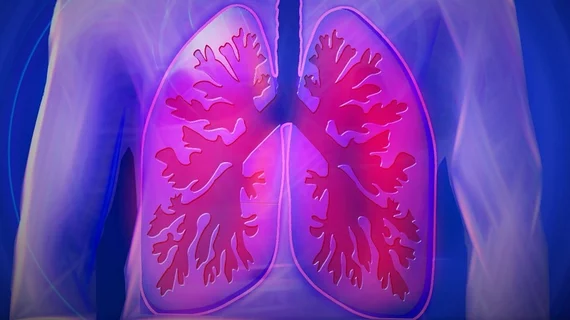AI offers faster, easier pulmonary nodule detection
Artificial intelligence can enhance radiologists’ ability to detect pulmonary nodules on chest CT scans while simultaneously reducing chest CT scan interpretation times.
Kai Liu, MD, of Shanghai Changzheng Hospital in China and colleagues published their findings online May 29 in Radiology: Artificial Intelligence.
The researchers set out to draw a comparison between sensitivity in the detection of lung nodules by radiologists and AI in the form of a deep learning (DL) model, using various patient population and scanning parameters to do so. They also sought to assess whether the radiologists’ detection performance could be enhanced when using the DL model for assistance.
The DL model comprised two convolutional neural networks (CNNs), one to extract image feature maps and the other, to detect the lung nodules. It was trained and tested using 12,754 thin-section chest CT scans, all of which had been retrospectively gathered from multiple hospitals in China, then independently reviewed and annotated by two radiologists with approximately 10 years of experience in reading chest CT studies.
This evaluation revealed that the DL model had 74% sensitivity when there was one false-positive result per scan and 86% percent sensitivity when there were eight false positives per exam.
While the model proved to be more sensitive for solid nodules larger than 6 mm, as well as for calcified nodules, it was less sensitive for smaller nodules.
No significant differences in performance based on patient dose, patient age range or CT scanner manufacturer were identified.
"Such results were consistent with expectations: larger nodules had more abundant features, and the calcified nodules typically had higher signal intensity on CT images," the researchers wrote. "Adjusting detection layer resolution of the model may improve the detection of smaller nodules."
Following the initial evaluation, two other radiologists, both of whom also had about a decade of experience with chest CT studies, were recruited to read two smaller batches of new exams, one with 123 cases and the other, with 148 cases. The radiologists first performed the task on their own and one week later, in tandem with the model. Liu et al then assessed the radiologists’ performance by calculating area under the curve (AUC). AUC for the first radiologist was 0.67 without the model and 0.77 with the model. AUC for the second radiologist was 0.65 without the model and 0.78 with the model.
The deep-learning model yielded an increase in sensitivity for both radiologists across all nodule types, according to the researchers. Additionally, on the second batch of exams, it was found to enhance radiologist performance on a per-patient level. Reading times also improved, from 15 minutes per patient to about five to 10 minutes per patient, the researchers discovered.
Liu et all concluded that when radiologists utilize a DL model for assistance, their performance improves and reading time is reduced. Accordingly, they wrote, “DL shows promise to enhance the identification of pulmonary nodules and benefit nodule management.”
